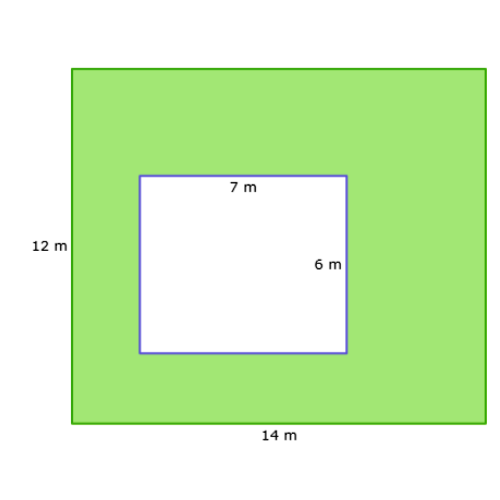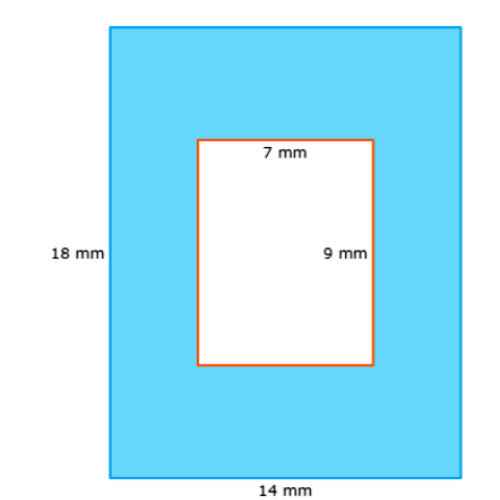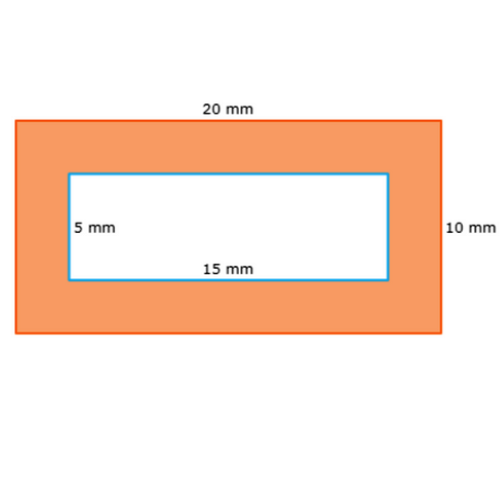Area between two rectangles
Key Notes :
🟦 Area Between Two Rectangles 📐
1️⃣ What is Area?
- Area = The space inside a shape.
- Formula for a rectangle:
Area=Length×Breadth (A=l×b)\text{Area} = \text{Length} \times \text{Breadth} \, (A = l \times b) Area=Length×Breadth(A=l×b)
- 🖍️ Example: A rectangle 5 cm × 3 cm → Area = 5 × 3 = 15 cm² ✅
2️⃣ Understanding “Area Between Two Rectangles” 🏠➖🏠
- Sometimes, we have one big rectangle and one smaller rectangle inside it.
- The area between them = Area of big rectangle − Area of small rectangle
Area Between=Area of Big Rectangle−Area of Small Rectangle\text{Area Between} = \text{Area of Big Rectangle} – \text{Area of Small Rectangle}Area Between=Area of Big Rectangle−Area of Small Rectangle
- 🎨 Think of it like coloring the border around the smaller rectangle.
3️⃣ Steps to Find Area Between Two Rectangles ✏️
- Measure length and breadth of the big rectangle 📏
- Measure length and breadth of the small rectangle 📐
- Calculate area of big rectangle Abig=l×bA_{big} = l \times bAbig=l×b 🟩
- Calculate area of small rectangle Asmall=l×bA_{small} = l \times bAsmall=l×b 🟦
- Subtract: Area Between=Abig−Asmall\text{Area Between} = A_{big} – A_{small}Area Between=Abig−Asmall ➖
4️⃣ Example 🌟
- Big rectangle: 10 cm × 6 cm → Area = 60 cm²
- Small rectangle inside: 4 cm × 3 cm → Area = 12 cm²
- Area between rectangles = 60 − 12 = 48 cm² ✅
💡 Tip: Always check units (cm², m², etc.)
5️⃣ Fun Visual Tip 🎨
- Draw the big rectangle in one color 🟩
- Draw the small rectangle inside in another color 🟦
- Shade the remaining part to see the area between clearly ✏️✨
Learn with an example
✈️ What is the area of the shaded region?

_________square metres.
- To find the area of the shaded region, subtract the area of the inner shape from the area of the outer shape. Start by finding the area of the inner shape.
- Find the base and height of the inner rectangle.
- base: 7 m
- height: 6 m
- Use these numbers in the formula.
- inner area
- = base height
- = 76
- = 42
- Now find the units. The lengths are measured in metres, so the area is measured in square metres.
- The area of the inner rectangle is 42 square metres.
- Next, find the area of the outer shape.
- Find the base and height of the outer rectangle.
- base: 14 m
- height: 12 m
- Use these numbers in the formula.
- outer area
- = base height
- = 1412
- = 168
- As with the inner rectangle, the lengths of the outer rectangle are measured in metres. So, the area is measured in square metres.
- The area of the outer rectangle is 168 square metres.
- Finally, subtract the inner area from the outer area to find the area of the shaded region.
- shaded area
- = 168–42
- = 126
- The area of the shaded region is 126 square metres.
✈️ What is the area of the shaded region?

_________square millimetres.
- To find the area of the shaded region, subtract the area of the inner shape from the area of the outer shape. Start by finding the area of the inner shape.
- Find the base and height of the inner rectangle.
- base: 7 mm
- height: 9 mm
- Use these numbers in the formula.
- inner area
- = base height
- = 79
- = 63
- Now find the units. The lengths are measured in millimetres, so the area is measured in square millimetres.
- The area of the inner rectangle is 63 square millimetres.
- Next, find the area of the outer shape.
- Find the base and height of the outer rectangle.
- base: 14 mm
- height: 18 mm
- Use these numbers in the formula.
- outer area
- = base height
- = 1418
- = 252
- As with the inner rectangle, the lengths of the outer rectangle are measured in millimetres. So, the area is measured in square millimetres.
- The area of the outer rectangle is 252 square millimetres.
- Finally, subtract the inner area from the outer area to find the area of the shaded region.
- shaded area
- = 252–63
- = 189
- The area of the shaded region is 189 square millimetres.
✈️ What is the area of the shaded region?

__________square millimetres.
- To find the area of the shaded region, subtract the area of the inner shape from the area of the outer shape. Start by finding the area of the inner shape.
- Find the base and height of the inner rectangle.
- base: 15 mm
- height: 5 mm
- Use these numbers in the formula.
- inner area
- = base height
- = 155
- = 75
- Now find the units. The lengths are measured in millimetres, so the area is measured in square millimetres.
- The area of the inner rectangle is 75 square millimetres.
- Next, find the area of the outer shape.
- Find the base and height of the outer rectangle.
- base: 20 mm
- height: 10 mm
- Use these numbers in the formula.
- outer area
- = base height
- = 2010
- = 200
- As with the inner rectangle, the lengths of the outer rectangle are measured in millimetres. So, the area is measured in square millimetres.
- The area of the outer rectangle is 200 square millimetres.
- Finally, subtract the inner area from the outer area to find the area of the shaded region.
- shaded area
- = 200–75
- = 125
- The area of the shaded region is 125 square millimetres.
Let’s practice!🖊️

